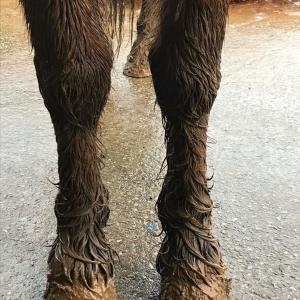
By Vet Charlotte Pennington
Winter usually brings waterlogged fields and lots of mud, so it is no surprise that we see increased cases of mud fever at this time.
Mud fever is a complicated skin reaction affecting horses’ lower limbs. It is not contagious and has many different factors that contribute to its cause. Most often it is as result of a skin irritation. Subsequently there is a bacterial infection by Dermatophilus Congolensis leading to pain, irritation and the formation of scabs.
Damaged skin allows bacteria which are normally present in the environment to enter the skin and establish an infection. Leg mites, excess leg washing, incorrectly fitted boots, pasture with rough vegetation and pre-existing medical conditions are all other factors that complicate this condition and predispose the skin to infection.
The back of the pasterns are most commonly affected. Early signs include reddening and thickening of the skin. As infection progresses, there is a greasy appearance and oozing of the skin which dries to form scabs containing pus that harbours more bacteria. In very severe cases the leg may swell up and the horse become lame.

Treatment involves firstly removing the horse from the muddy environment into a clean dry bed. Affected areas should be clipped to remove hair. Dilute antiseptics such as chlorhexidine should be used to gently clean the affected area twice daily after which it should be towel dried. Loose scabs should be removed but resist removing any firmly attached scabs as this can be painful. After initial cleaning silver cream or silver dressings can be applied daily to promote skin healing.
If there is a poor response to initial treatment or the mud fever gets worse, contact your vet. A blood test may be required. Or a swab may be taken to check for bacterial growth and sensitivity, allowing for the appropriate use of antibiotics.